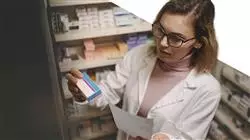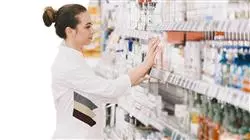University certificate
The world's largest faculty of pharmacy”
Description
A Master's Degree that will give you the keys you need to launch your next Parapharmacy project with guaranteed success”

The parapharmacy sales ecosystem shows a clear upward trend in online shopping across a wide range of products. The pandemic caused by the coronavirus, as well as new digital technologies, have increased interest in online parapharmacies and many professionals are choosing to incorporate this business model.
A task that requires being up to date with the main marketing and commercial actions in the digital world, their combination with other existing physical Pharmacy businesses, as well as the entire market surrounding the sector. In this sense, TECH has created this Master's Degree that provides the professional with the most current information so that it can promote the creation, design and implementation of a successful Parapharmacy.
Whatever their type of business, pharmacists will obtain in this program a broad and exhaustive vision of this industry, the necessary tools for the creation of financial plans, the marketing of products, customer service and the new role they play in the team working in a Parapharmacy.
It is, therefore, a university degree oriented to provide the most advanced syllabus in only 1,500 teaching hours and with the best specialized teaching staff of the moment. In addition, in this updating process, students have access to video summaries of each topic, videos in detail, readings and case studies that will give greater dynamism and attractiveness to this degree.
Undoubtedly, a unique opportunity to be aware of everything that surrounds Parapharmacy through an academic option that does not require attendance, nor does it have classes with fixed schedules. This flexibility allows the graduate to access the syllabus whenever and wherever they wish. You only need an electronic device with internet connection to view, at any time, the content of this Master's Degree, an unparalleled opportunity that only TECH offers.
Do you want to keep up to date with the software used in the management of Parapharmacies? Do it through this degree and incorporate them into your business”
This Professional Master's Degree in Parapharmacy contains the most complete and up-to-date scientific program on the market. The most important features include:
- The development of practical cases presented by experts in Pharmacy
- The graphic, schematic, and practical contents with which they are created, provide practical information on the disciplines that are essential for professional practice
- Practical exercises where self-assessment can be used to improve learning
- Its special emphasis on innovative methodologies
- Theoretical lessons, questions to the expert, debate forums on controversial topics, and individual reflection assignments
- The availability of access to content from any fixed or portable device with an Internet connection
This degree will lead you to delve into the relevant logistics and the main actors in the distribution chain of parapharmaceutical products”
The program’s teaching staff includes professionals from sector who contribute their work experience to this educational program, as well as renowned specialists from leading societies and prestigious universities.
Its multimedia content, developed with the latest educational technology, will provide the professional with situated and contextual learning, i.e., a simulated environment that will provide an immersive education programmed to learn in real situations.
The design of this program focuses on Problem-Based Learning, by means of which the professional must try to solve the different professional practice situations that are presented throughout the academic course. For this purpose, the student will be assisted by an innovative interactive video system created by renowned experts.
Thanks to the Relearning method, used by TECH, you will reduce the long hours of study and memorization"

Delve into the profitability of parapharmaceutical products and existing categories and integrate them into your business plan"
Syllabus
The faculty that teaches this university program has extensive experience in the pharmaceutical sector, which is evident in the high quality syllabus of this Master's Degree. In this way, the professional will be able to delve for 12 months in the key concepts for the development and implementation of a on-site or online Parapharmacy. In addition, you will be able to incorporate the latest existing technologies for financial control, product sales or in the implementation of marketing campaigns. A comprehensive tour that will be made more dynamic thanks to the multimedia teaching materials and the numerous additional pedagogical contents.

This is a flexible academic option that will allow you to combine your daily professional activities with a quality Master's Degree”
Module 1. Parapharmacy Basics
1.1. Parapharmacy Evolution
1.1.1. Parapharmacy History
1.1.2. Evolution of Parapharmacy
1.1.3. Parapharmacy Definition
1.1.4. Difference between Pharmacy and Parapharmacy
1.2. Parameters Measurement in Parapharmacy
1.2.1. Parameter Definition
1.2.2. Parameters Structure
1.2.3. Main Parameters
1.2.4. Parapharmacy Parameter Analysis
1.3. Main Products in the Parapharmacy
1.3.1. Cosmetics and Personal Care Products
1.3.2. Food Supplements
1.3.3. Infant Nutrition
1.3.4. Food for Special Medical Use
1.3.5. Dietary Substitute Foods
1.3.6. Medical Devices
1.3.7. In vitro Diagnostic and Self-diagnostic Medical Devices
1.3.8. Childcare Articles
1.3.9. Biocides
1.3.10. Personal Protective Equipment (PPE)
1.3.11. Other Health and Wellness Related Products for Sale in Pharmacies
1.4. Parapharmacy and Health
1.4.1. Relationship between Parapharmacy and Health
1.4.2. Health as a Central Element
1.4.3. Healthy Living
1.4.4. Conclusions
1.5. Types of Parapharmacies
1.5.1. Private Parapharmacy
1.5.2. Parapharmacy Franchise
1.5.3. Parapharmacy Department Store
1.5.4. Parapharmacy in the Retail sector
1.6. Competitive Analysis
1.6.1. Definition
1.6.2. Objectives
1.6.3. Applications
1.6.4. Results
1.7. Parapharmacy Roles
1.7.1. Staff, Who is Who?
1.7.2. Parapharmacy Management
1.7.3. Technical Staff
1.7.4. Administrative Staff
1.8. Team Coaching in Parapharmacy
1.8.1. Human resources
1.8.2. Day-to-Day Management
1.8.3. Motivation
1.8.4. Conclusions
1.9. Technological Elements in Parapharmacy
1.9.1. Definition
1.9.2. Technological Elements in Parapharmacy
1.9.3. Importance of Parapharmaceutical Technology
1.9.4. Technological Innovations in Parapharmacy
1.10. Corporate Social Responsibility in Parapharmacy
1.10.1. Definition
1.10.2. Good Environmental Practices
1.10.3. Good Conservation Practices
1.10.4. Good Customer Service Practices
Module 2. Parapharmacy Trade Marketing
2.1. Trade Marketing: Functions
2.1.1. Trade Marketing Definition
2.1.2. Pharmaceutical Trade Marketing Functions
2.1.3. Main Trade Marketing Techniques
2.1.4. The 4 P's
2.2. Parapharmacy Lineal
2.2.1. What is the Parapharmacy Lineal?
2.2.2. Exposure Levels
2.2.3. Hot Spots
2.2.4. Cold Spots
2.3. The Counter
2.3.1. Tips for a Dazzling Countertop
2.3.2. Counter Layout
2.3.3. Importance of the Counter
2.3.4. Seasonal Placement of Counter According to Season
2.4. The Cashkeeper Smart Cash Drawer
2.4.1. Definition
2.4.2. Structure
2.4.3. What Is It For?
2.4.4. Usage Benefits
2.5. Parapharmacy Showcase
2.5.1. Tips for a Dazzling Showcase
2.5.2. Showcase Layout
2.5.3. The Importance of the Showcase
2.5.4. Placement of the Showcase According to the Season
2.6. Sell In and Sell Out in Parapharmacy
2.6.1. Differences between Sell InandSell Out
2.6.2. What is the Sell In?
2.6.3. What is the Sell Out?
2.6.4. Sell In and Sell Out as Performance Indicators
2.7. Suppliers as Partners
2.7.1. Supplier Involvement
2.7.2. Merchandising
2.7.3. Types of Suppliers
2.7.4. Synergy Between Supplier and Parapharmacy
2.8. Mobile Marketing in Parapharmacy
2.8.1. Definition
2.8.2. Main Structures
2.8.3. Objectives
2.8.4. Multidevice
2.9. Social Marketing in Parapharmacy
2.8.1. Definition
2.8.2. Main Structures
2.8.3. Objectives
2.8.4. Analyze Attitudes, Beliefs, Values and Behaviors
2.10. Parapharmacy Video Marketing
2.10.1. Definition
2.10.2. Main Structures
2.10.3. Objectives
2.10.4. Video Content and Format
Module 3. Dermocosmetics in Parapharmacy
3.1. Dermocosmetics Market
3.1.1. Definition
3.1.2. Objectives
3.1.3. Analysis of the Cosmetics and Dermocosmetics Market in the Pharmacy/Parapharmacy
3.1.4. SWOT Analysis
3.2. Dermocosmetic Active Ingredients
3.2.1. Definition
3.2.2. Main Active Principles
3.2.3. Uses of Active Ingredients
3.2.4. Benefits of Active Ingredients
3.3. Main Formulations for Dermocosmetic Products
3.3.1. Definition
3.3.2. Main Formulas
3.3.3. Uses of the Formulas
3.3.4. Benefits of the Formulas
3.4. Photoprotection in Parapharmacy
3.4.1. Definition
3.4.2. Main Photoprotectors
3.4.3. Uses of Photoprotectors
3.4.4. Benefits of Photoprotectors
3.5. Main Dermocosmetic Products
3.5.1. Dermatological: for the Treatment of Sensitive or Problematic Skin
3.5.2. Cosmetic or Selective: for More Complete Routines and Absence of Skin Pathologies
3.5.3. Premium: More Advanced and Innovative High-end Cosmetic Products and Creams
3.5.4. Natural or Organic: Composed by Ingredients of Vegetable Origin
3.6. Dermocosmetics as Prevention
3.6.1. Origin
3.6.2. Definition
3.6.3. Objectives
3.6.4. Conclusions
3.7. Dermocosmetics Importance in Parapharmacy
3.7.1. Dermocosmetics With More and More Space in Parapharmacy
3.7.2. Dermocosmetics Market Trends in Parapharmacy
3.7.3. Dermoesthetic Placement in Parapharmacies
3.7.4. Conclusions
3.8. Skin Types
3.8.1. How to Identify Skin Types?
3.8.2. The Four Skin Types
3.8.3. Type Evaluation
3.8.4. Skin Condition
3.9. Hair Dermocosmetics
3.9.1. Definition
3.9.2. Definition of objectives
3.9.3. Hair Problems
3.9.4. Treatment of Problems with Hair Dermocosmetics
3.10. Latest Technology in Dermocosmetics
3.10.1. Facial Dermal Analysis
3.10.2. Hair Analysis
3.10.3. 3D Analysis
3.10.4. Technological Future of the Industry
Module 4. Dietetic-food supplements
4.1. Food Supplements in the 21st Century
4.1.1. Definition
4.1.2. Structure
4.1.3. What Are They For?
4.1.4. Main Products
4.1.5. Main Differences:
4.2. Differences Between Food Supplement, Nutricosmetic and Dietary Supplement
4.2.1. Food Supplement
4.2.2. Nutricosmetics
4.2.3. Dietary Supplements
4.2.4. Main Differences:
4.3. Main Ingredients in Food Supplements
4.3.1. Minerals
4.3.2. Fibre
4.3.3. Vitamins
4.3.4. Amino Acids
4.3.5. Polyunsaturated Fatty Acids(AGPI)
4.3.6. Probiotics and Plants
4.4. Nutricosmetics
4.4.1. What is Nutricosmetics?
4.4.2. Cosmetic or Nutricosmetic
4.4.3. Nutricosmetics Uses: Skin
4.4.4. Nutricosmetics Uses: Hair
4.5. Dosage Forms and Food Supplements
4.5.1. What are Dosage Forms?
4.5.2. Different Types of Dosage Forms
4.5.3. Traditional Dosage Forms
4.5.4. Modern Dosage Forms
4.6. Dietetics and Nutrition
4.6.1. Differences and Similarities Between Both
4.6.2. Nutrition and Dietetics Branches
4.6.3. Diet
4.6.4. Types of Diets
4.7. Medicinal Plants
4.7.1. Brief Introduction to Phytotherapy
4.7.2. What are Medicinal Plants?
4.7.3. What Are Medicinal Plants Used For?
4.7.4. What are the Main Medicinal Plants and their Main Pharmacological Action?
4.8. Vitamins and minerals
4.8.1. What Kind of Vitamins are Sold in a Parapharmacy?
4.8.2. Different Types of Vitamins and Minerals: Vitamin Complexes
4.8.3. Bestsellers
4.8.4. The Vitamin Market
4.9. Food Supplements Market
4.9.1. Food Supplements: “an Upward Trend
4.9.2. Self-Consumption
4.9.3. Which Are the Bestsellers
4.9.4. Types
4.10. Applied Technology for Dietetics
4.10.1. Latest Technological Advances
4.10.2. Technological Innovation
4.10.3. Main Technological Advances
4.10.4. Main Applications
Module 5. Parapharmacy Categories
5.1. History
5.1.1. Definition
5.1.2. Structure
5.1.3. What Is It For?
5.1.4. Main Products
5.2. Hair Care
5.2.1. Definition
5.2.2. Structure
5.2.3. What is it for?
5.2.4. Main Products
5.3. Man
5.3.1. Definition
5.3.2. Structure
5.3.3. What Is It For?
5.3.4. Main Products
5.4. Children (Feeding and Hygiene)
5.4.1. Definition
5.4.2. Structure
5.4.3. What Is It For?
5.4.4. Main Products
5.5. Hygiene
5.5.1. Definition
5.5.2. Structure
5.5.3. What Is It For?
5.5.4. Main Products
5.6. Oral Care
5.6.1. Definition
5.6.2. Structure
5.6.3. What Is It For?
5.6.4. Main Products
5.7. Personal Care
5.7.1. Definition
5.7.2. Structure
5.7.3. What Is It For?
5.7.4. Main Products
5.8. First Aid Kit
5.8.1. Definition
5.8.2. Structure
5.8.3. What Is It For?
5.8.4. Main Products
5.9. Orthopedics
5.9.1. Definition
5.9.2. Structure
5.9.3. What Is It For?
5.9.4. Main Products
5.10. Optics
5.10.1. Definition
5.10.2. Structure
5.10.3. What Is It For?
5.10.4. Main Products
Module 6. Parapharmacy Profitability
6.1. Accounting and Finance of a Parapharmacy
6.1.1. Basic Accounting Aspects
6.1.2. Assets in Parapharmacy Accounting
6.1.3. Liabilities in Parapharmacy Accounting
6.1.4. Types of IVA. Taxes
6.2. Purchase Management
6.2.1. Suppliers
6.2.2. Stock Management
6.2.3. ABC Products
6.2.4. Parapharmacy Purchasing Types
6.3. Sales Management
6.3.1. Pharmacy Activity Sales
6.3.2. POS as a Sales Tool for Parapharmacies
6.3.3. Costs and Expenses
6.3.4. Net Income
6.4. Parapharmacy Margin PVL, PVF and PVP
6.4.1. What is PVL?
6.4.2. PVP Calculation
6.4.3. Net Margin, and Differences Between PVL, PVF and PVP
6.4.4. How to Improve Margin
6.4.5. Pharmacy Amortization
6.5. Sales Plan for a Parapharmacy
6.5.1. How to Develop a Sales Plan
6.5.2. Customer Loyalty
6.5.3. Sales Incentive Planning
6.5.4. Staff Incentives for Sales
6.6. Tools to Study the Sales of a Parapharmacy
6.6.1. Customer Shopping Experience
6.6.2. Upselling
6.6.3. Cross Selling
6.6.4. Packs
6.6.5. Bidding Techniques for a Parapharmacy
6.7. Main Software: Farmatic, Unycop and Bitfarma
6.7.1. Which One to Choose? SL, CB, SA or Self-Employed
6.7.2. Equivalence Surcharge
6.8. Payment Types
6.8.1. Payments to Suppliers
6.8.2. Deferral of Payments
6.9. Financial Plan
6.9.1. Investment Plan
6.9.2. Balance
6.9.3. Cash Budget
6.9.4. Interim Profit and Loss Statement
6.9.5. Treasury Plan
6.10. The Profit Margin of a Parapharmacy
6.10.1. Negotiation with Suppliers
6.10.2. Cost Savings on Purchases
6.10.3. Supplier Discounts for Prompt Payment
6.10.4. Increasing the Opening Hours of the Parapharmacy
Module 7. Parapharmaceutical Distribution
7.1. Innovative Technology for Parapharmaceutical Distribution
7.2. Logistics
7.2.1. Order Preparation
7.2.2. Order Delivery
7.2.3. Delivery Notes and Invoices
7.2.4. Good Practices
7.3. Parapharmacy Products Distribution Chain
7.3.1. Distribution Players: Who are they?
7.3.2. What Is a Wholesaler?
7.3.3. What Is a Distributor?
7.3.4. What is a Purchasing Group?
7.3.5. Parapharmacy as a Final Point of Sale to the Customer
7.4. ICT Management of the Parapharmacy Warehouse
7.4.1. What is the Parapharmacy Warehouse?
7.4.2. Ordering and Procurement Management
7.4.3. Receipt of Incoming Goods
7.4.4. Storage and Placement of Products
7.5. Parapharmaceutical Market
7.5.1. Market Presentation and Definition in Figures
7.5.2. The Domestic Market
7.5.3. Demand Analysis: Use of Beauty and Personal Care products Consumer Purchasing Behavior
7.5.4. Market structure
7.6. Stock Management
7.6.1. Optimal Stock Management in Parapharmacy
7.6.2. Optimal Inventory of the Parapharmacy is Based on the Analysis of 10 Variables
7.6.3. Turnover Ratio and Optimal Stock Management Levels in the Parapharmacy
7.6.4. Conclusions
7.7. Parapharmacy Order Types
7.7.1. Order Management in the Parapharmacy
7.7.2. What Types of Orders Are There in a Parapharmacy?
7.7.3. How Are Orders Placed?
7.7.4. Other Options
7.8. Quality of Parapharmacy Products
7.8.1. Product Labeling
7.8.2. National Code of Parapharmacy Products as a Quality Guarantee
7.8.3. Quality Image of Parapharmacy Products
7.8.4. Parapharmacy as a Sales Channel Ensures Product Quality
7.9. End Customer
7.9.1. Active Sales
7.9.2. Recommendations for Moving from Active Selling to Selling Advice
7.9.3. Customer Knowledge
7.9.4. End Customer
7.10. Keys to Parapharmacy Management
7.10.1. Tips to Optimize Parapharmacy Management
7.10.2. Parapharmacy Management Areas
7.10.3. Practical Advice
7.10.4. Conclusions
Module 8. Attention to Parapharmacy
8.1. Parapharmaceutical Advice
8.1.1. What is Parapharmaceutical Advice and What Should it Look Like?
8.1.2. The Importance of Parapharmaceutical Advice for the Customer
8.1.3. Parapharmacy Consultation
8.1.4. Conclusions
8.2. The Pharmacist/Parapharmacist as a Health Consultant
8.2.1. Its Importance as a Health Expert
8.2.2. Customization for the Customer
8.2.3. Customer Follow-Up
8.2.4. After Sales Service
8.3. Customer Psychology
8.3.1. Health Space for the Client
8.3.2. Dietetic and Beauty Consultations
8.3.3. Customer Knowledge
8.3.4. Customer Strategies
8.4. Customer Loyalty
8.4.1. The Pharmacist's Advice as a Tool to Build Customer Loyalty
8.4.2. Customer Loyalty Tools
8.4.3. Ongoing Customer Support
8.4.4. The Customer at the Center of the Business
8.5. Health Corner in Parapharmacy
8.5.1. Optimize Sales
8.5.2. Increasing Sales in Parapharmacy
8.5.3. Personalized Customer Service According to your Health Needs
8.5.4. Conclusions
8.6. Types of Clients
8.6.1. The Importance of an Aligned Team with the Parapharmacy's Strategy
8.6.2. Customer Classification
8.6.3. Customer Treatment According to Its Classification
8.6.4. The Parapharmacy Team as a Health Advisor to the Customer
8.7. Smart Lockers
8.7.1. Getting Started with Smart Locker
8.7.2. Getting the Most Out of My Smart Locker
8.7.3. Smart Locker Usage Requirements
8.7.4. Parapharmacy as a Technological Paradigm
8.8. Personalized Care
8.8.1. Identify the Customer
8.8.2. Take Care of Your Customer
8.8.3. Communication With the Customer Is the Priority Tool for Closing the Sale
8.8.4. Conclusions
8.9. New Technologies in Parapharmacy
8.10. Customer Training
8.10.1. Training Workshops
8.10.2. Product Talks
8.10.3. Marketing Aimed at Customer Training
8.10.4. Conclusions
Module 9. Parapharmacy Marketing Plan
9.1. Marketing Concepts
9.1.1. Introduction to General Marketing
9.1.2. Product Strategy
9.1.3. Pricing Strategy
9.1.4. Segmentation and Positioning
9.2. Objective of a Parapharmacy Marketing Plan
9.2.1. Promote the Implementation of Commercial Activities in the Parapharmacy Sales Area
9.2.2. Increase the Sale of Parapharmacy Products
9.2.3. Parapharmacy Product Stock Rotation
9.2.4. Enhance the Brand of Our Parapharmacy and Counteract the Competition
9.3. Parapharmacy Marketing Campaigns Types
9.3.1. Promotional Campaign
9.3.2. Testimonial Campaign
9.3.3. Marketing Campaign in RRSS
9.3.4. Product Launch Campaign
9.4. Marketing Plan Steps
9.4.1. Conduct an External and Internal Analysis
9.4.2. SWOT Analysis
9.4.3. Establishing the Communication Strategy and Action Plan
9.4.4. Planning the Marketing Plan: the Campaign
9.4.5. Team Communication
9.4.6. Campaign Evaluation
9.5. What is Viral Marketing in Parapharmacy?
9.5.1. Viral Marketing Definition
9.5.2. Word of Mouth
9.5.3. Viral Marketing Outreach
9.5.4. Viral Marketing Examples
9.6. Parapharmacy Identity
9.6.1. Identity Trend
9.6.2. Identity Marketing
9.6.3. Identity Techniques
9.6.4. Conclusions
9.7. Cross Selling Techniques
9.7.1. Definition
9.7.2. Main Techniques
9.7.3. Profit
9.7.4. Best Practices
9.8. Parapharmacy Merchandising
9.8.1. Merchandising Types
9.8.2. Different Merchandising Interests
9.8.3. Brand Image Provider
9.8.4. The Consumer: Choice of Assortment and Appeal
9.9. Consumer Shopping Experience
9.9.1. Type of Customer
9.9.2. Personalization
9.9.3. Communication With the Client
9.9.4. New Technologies for Customer Communication
9.10. Parapharmacy Sales Analysis
9.10.1. Best Selling Products
9.10.2. Stock Turnover and Periodicity
9.10.3. ROI
9.10.4. Lesser Sold Products Stock Elimination
Module 10. Online Parapharmacy
10.1. Different Forms of Online Parapharmacy
10.1.1. Definition of an Online Parapharmacy
10.1.2. Online Parapharmacy as E-commerce: a New Way to Shop Online
10.1.3. Online Parapharmacy as a Great Business Opportunity
10.1.4. Online Entrepreneurship
10.2. Advantages of an Online Parapharmacy
10.2.1. Longer Range
10.2.2. Open 24 24/ 7
10.2.3. Lower Cost and Higher Profit
10.2.4. Digital Marketing Strategy
10.3. Disadvantages of an Online Parapharmacy
10.3.1. Internet Distrust
10.3.2. Product Must Not Be Touched
10.3.3. Internet Access by Seniors
10.3.4. Sector Competition
10.4. 3D Web
10.4.1. Definition
10.4.2. Market
10.4.3. Techniques
10.4.4. Conclusions
10.5. E-commerce: The New Normal
10.5.1. COVID-19 Effect: Increase in Online Sales
10.5.2. Online Shopping Tool
10.5.3. Store Pickup
10.5.4. Attracts Traffic to the Physical Parapharmacy
10.6. Digital Purchasing
10.6.1. Price and Offer
10.6.2. Customer Confidence
10.6.3. After Sales Service
10.6.4. Customer Shopping Experience
10.7. How to Create Your Online Parapharmacy Advice
10.7.1. Establish Objectives A Good Name for your E-commerce - Online Parapharmacy
10.7.2. SSL Certified
10.7.3. Build Your Website with Professionals
10.7.4. Responsive Web
10.7.5. Sales Funnel
10.7.6. Create a Good Homepage
10.7.7. Product Description
10.7.8. After Sales
10.8. Online Parapharmacy Positioning (SEO)
10.8.1. Local SEO for Local Referencing
10.8.2. SEO to Position the Categories, Brands or Products of Your Online Parapharmacy
10.8.3. Publish Content that Ranks on Google: Blogging and Content Marketing
10.8.4. Make a Good Backlinks Plan
10.9. Social Networks in Online Parapharmacy
10.9.1. Main RRSS: Facebook, Instagram, YouTube and LinkedIn
10.9.2. What to Do to Sell Through Social Networks?
10.9.3. Analyze your Competition
10.9.4. What Can We Do to Gain Followers?
10.10. SEM in Online Parapharmacy
10.10.1. How to Run an SEM Campaign?
10.10.2. Google Ads: What is it?
10.10.3. Facebook Ads: What is it?
10.10.4. Choosing a SEO and SEM Digital Marketing Agency

A unique training experience, key and decisive to boost your professional development"
Professional Master's Degree in Parapharmacy
Are you interested in acquiring advanced knowledge in the field of parapharmacy? Then the Professional Master's Degree in Parapharmacy from TECH Global University is for you! This program gives you the opportunity to specialize in health and wellness products, so you can improve the quality of life of your patients. Our Master in Parapharmacy is taught in virtual mode, which means that you can access classes from anywhere in the world, without having to travel. This methodology allows you to organize your study time in a flexible way, so you can adapt it to your needs.
Broaden your knowledge in the world of health and wellness products.
During the program, you will have the opportunity to learn about the different types of parapharmaceutical products, as well as their composition, manufacture and use. You will also acquire knowledge about the regulations and norms applicable in this sector, so that you can exercise your professional work in an ethical and responsible manner. At TECH Global University, we have a team of highly qualified professors with experience in the sector, who will provide you with a complete and updated training. In addition, during the master's degree you will have access to innovative technological tools that will help you maximize your learning. Don't miss the opportunity to expand your knowledge in the world of health and wellness products - enroll now in the Professional Master's Degree in Parapharmacy and become an expert in the field!







